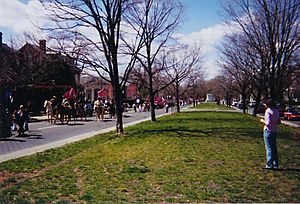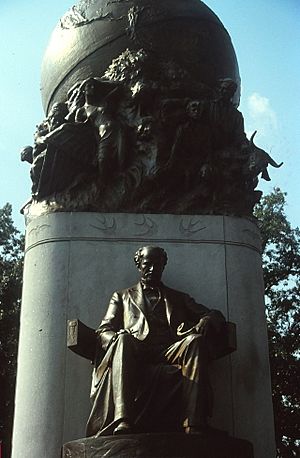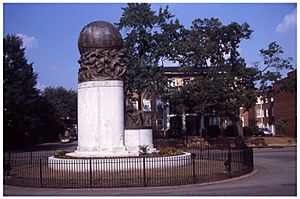Monument Avenue facts for kids
|
Monument Avenue Historic District
|
|

Former Location of Jefferson Davis Memorial on Monument Avenue, Richmond, Virginia
|
|
| Location | Bounded by Grace and Birch Sts., Park Ave., and Roseneath Rd.; Roughly, Franklin St. from Roseneath Rd. to Cleveland St., Richmond, Virginia |
|---|---|
| Architect | John Russell Pope |
| Architectural style | Georgian, Gothic Revival |
| NRHP reference No. | 70000883 |
Quick facts for kids Significant dates |
|
| Added to NRHP | February 16, 1970 |
| Designated NHLD | December 9, 1997 |
Monument Avenue is a famous street in Richmond, Virginia. It has a wide, grassy area down the middle, lined with trees. This area used to hold many statues honoring leaders from the American Civil War. This war was fought between the northern and southern states of the United States from 1861 to 1865. The southern states formed the Confederacy.
Between 1900 and 1925, many beautiful homes, churches, and apartment buildings were built along Monument Avenue. In July 2020, four of the bronze statues were removed from their pedestals. These statues honored J. E. B. Stuart, Stonewall Jackson, Jefferson Davis, and Matthew Fontaine Maury. This happened during a time of public protests. Two statues still remain: the Robert E. Lee monument (from 1890) and the Arthur Ashe monument (from 1996). The Arthur Ashe monument honors an African American tennis champion.
After the death of George Floyd in 2020, many protests took place. During these events, the Davis monument was taken down by protestors. The Lee monument was also ordered to be removed by Virginia's Governor, Ralph Northam. In July 2020, Richmond's mayor, Levar Stoney, ordered the removal of other Confederate monuments on city land. These included statues of J.E.B. Stuart, Stonewall Jackson, and Matthew Fontaine Maury.
Before 2020, Monument Avenue was a popular place for yearly events, especially in the spring. These included the Monument Avenue 10K race. Sometimes, groups like the Sons of Confederate Veterans would gather there in old military costumes. Another spring tradition was "Easter on Parade." During this event, many Richmond residents would walk along the avenue wearing fancy Easter bonnets and other special clothes.
The "Monument Avenue Historic District" is a special part of the street. It starts at a traffic circle in the east and goes west for about fourteen blocks. This area is listed on the National Register of Historic Places as a National Historic Landmark District. This means it's a very important historical place.
The American Planning Association recognized Monument Avenue in 2007. They called it one of the "10 Great Streets in America." They praised its historic homes, different types of buildings, and how it handles different ways of travel. They also noted the community's effort to protect its history.
Contents
The Story of Monument Avenue
Monument Avenue began with an idea for a statue of General Robert E. Lee. This was after Lee passed away in 1870. People in Richmond wanted to build statues for three Virginians who had helped defend the city. City plans from 1887 show the suggested spot: a circle of land at the end of West Franklin Street. This street was a fancy residential area back then.
A wealthy Richmond resident, Otway C. Allen, owned this land. The plan for the statue included building a grand avenue stretching west. This avenue would have trees along a central grassy area. Allen planned to sell building plots along this new, grand avenue.
On May 29, 1890, huge crowds gathered to see the first monument unveiled. This was a very large memorial to Robert E. Lee. It's estimated that 100,000 people came to witness this event.
It took about 10 years for wealthy Richmonders and builders to start buying lots and constructing homes. But between 1900 and 1925, Monument Avenue saw a huge boom in building. Many important houses, churches, and apartment buildings were created. Famous architects like John Russell Pope and William Bottomley designed buildings here. Builders also constructed many houses to sell to people who didn't hire an architect.
Monument Avenue was once a favorite place for Richmond's upper-class families to live. The Fan District part of the avenue has many large mansions from the late 1800s. The Museum District section has big houses, apartment buildings, and smaller family homes. West of Interstate 195, Monument Avenue becomes more like a typical suburban street. However, it still keeps its wide lanes and large grassy median with trees.
Over the years, the avenue has changed. In the 1950s and 60s, many large houses were divided into apartments. Some houses were even torn down for parking lots or new buildings. But city rules helped protect the neighborhood's character. In 1969, a group called The Residents and Associates for the Preservation of Monument Avenue was formed. This group later changed its name to the Monument Avenue Preservation Society (MAPS) in 1970.
Changes to the Monuments
In August 2017, Richmond's Mayor Levar Stoney announced a plan to add information markers around the Confederate monuments. This was to explain their history better. At that time, Virginia law did not allow cities to remove such statues. However, in April 2020, a new law was passed. This law allowed local governments to remove monuments, except those in cemeteries or at the Virginia Military Institute. This new law took effect in July 2020.
On June 10, 2020, protestors took down the statue of Jefferson Davis. On July 1, 2020, the first day the new law was active, Mayor Stoney ordered the removal of the Stonewall Jackson statue. The Maury statue and a display of cannons were removed the next day, July 2. Mayor Stoney then announced plans to remove a total of 11 Confederate memorials.
The Monuments of Monument Avenue
Monument Avenue once featured several statues dedicated to Confederate military and political figures. Here's a look at them:
| Monument | Sculptor | Unveiled | Removed |
|---|---|---|---|
| Robert E. Lee Monument | Antonin Mercié | May 29, 1890 | pending removal |
| J. E. B. Stuart Monument | Frederick Moynihan | May 30, 1907 | July 7, 2020 |
| Jefferson Davis Memorial | Edward Valentine | June 3, 1907 | June 10, 2020 |
| Stonewall Jackson Monument | Frederick William Sievers | October 11, 1919 | July 1, 2020 |
| Matthew Fontaine Maury Monument | Frederick William Sievers | November 11, 1929 | July 2, 2020 |
The Avenue also includes a statue honoring Richmond native Arthur Ashe, a famous tennis player. This statue was created by Paul DiPasquale and unveiled on July 10, 1996.
J.E.B. Stuart Monument
The J. E. B. Stuart Monument was located at the eastern end of Monument Avenue. It was an equestrian (on horseback) bronze statue on a granite base. Sculpted by Fred Moynihan, it was unveiled in 1907. This was the second of the original monuments on the avenue. The statue showed Stuart facing east, while his horse faced north.
Discussions for the Stuart statue began as early as 1875. The competition to choose the sculptor happened in 1903. The location was chosen in 1904. The unveiling of the Stuart and Jefferson Davis monuments together drew even larger crowds than the Lee unveiling. Estimates ranged from 80,000 to 200,000 people.
The statue of Stuart was removed by the City of Richmond on July 7, 2020. Today, only the empty pedestal remains.
Robert E. Lee Monument
Just one block west is a large traffic circle that still holds the Robert E. Lee Monument. This monument was dedicated in 1890. It was the first and the largest of the monuments on the street.
Jefferson Davis Memorial
Four blocks west of the Lee monument was the Jefferson Davis Memorial. This monument featured a tall central column surrounded by a circle of pillars. It was unveiled in 1907, at the same time as the J.E.B. Stuart Monument. This spot was once the location of Star Fort, an old defense point for Richmond.
The bronze statue of Davis was taken down on June 10, 2020. This happened during the protests following the death of George Floyd.
Stonewall Jackson Monument
Three blocks west of where the Davis Memorial used to be was the equestrian statue of Stonewall Jackson. It was located at the intersection of Monument Avenue and North Boulevard.
Mayor Stoney ordered this monument removed on July 1, 2020. Like the Stuart monument, only the empty pedestal is left.
Matthew Fontaine Maury Monument
The Matthew Fontaine Maury Monument honored Matthew Fontaine Maury, known as the "Pathfinder of the Seas." It was located on Monument Avenue at Belmont Avenue.
In 1915, a group was formed to raise money for a monument to Maury. The United Daughters of the Confederacy also helped with fundraising. Even President Woodrow Wilson, who was from Virginia, joined the effort.
Richmond sculptor Frederick William Sievers was chosen to create the statue. This monument was known for being the "most allegorical" (meaning it used many symbols) of Richmond's monuments. It was unveiled on November 11, 1929, as part of an Armistice Day celebration.
The statue of Maury faced east, towards the Atlantic Ocean. Maury, the "Pathfinder of the Seas," had created many charts of the ocean. He held a pencil, a compass, and a copy of his charts. Next to him was his book, Physical Geography of the Sea, and a Bible. These showed the important role faith played in his life.
Behind his head was a globe of the Earth, tilted slightly. It showed both land and sea. A calm woman stood between the land and sea, representing Mother Nature. Around the base of the globe were images of people clinging to a sinking boat in bad weather. This showed the dangers of the sea. On the right side of the globe, there was a farmer, a boy, and a dog. These represented Maury's work in promoting land weather services.
Maury attended a conference in Brussels, Belgium, in 1853. He shared his ideas about land and sea weather predictions. Many nations agreed to follow his ideas for safety at sea. He believed that ships at sea were "a thousand temples of science for all of humanity." He thought they brought people and nations closer by helping protect against storms and deaths. The monument also had fish, dolphins, jellyfish, and birds around its edge.
The statue of Maury was removed on July 2, 2020. The globe part of the monument was removed on July 9.
Arthur Ashe Monument
Almost a century after the first monuments were placed, the Richmond community approved a statue of Arthur Ashe. It was created by Paul DiPasquale and placed on Monument Avenue. Some people felt the statue didn't fit with the Confederate leaders already on the avenue. Others thought it should be at the Arthur Ashe Athletic Center.
However, many residents felt Ashe deserved a place on the avenue. They pointed to his important role in the city's modern history. Ashe's statue was the farthest one placed on the avenue. It is located in the Museum District, just west of the city's Fan District.
Images for kids










